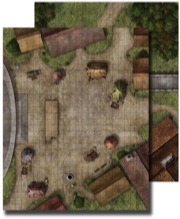| lordvargon |
This appears to exactly represent the town square in front of the Sandpoint Cathedral from the Rise of the Runelords Adventure Path. I think this is awesome!
I'd really like to see at least some of the mundane locations in the Adventure Paths and Modules feature the GameMastery Flip-Maps and Map Packs. Heck, it would be cool if the maps were even featured in the Pathfinder Society Sanctioned Modules.
I really like using props in my games, but I don't do a lot of custom adventure design. I have many of the flip-maps and map packs but I almost never find a reason to use them.
 James Jacobs
Creative Director
James Jacobs
Creative Director
|
| 1 person marked this as a favorite. |
This appears to exactly represent the town square in front of the Sandpoint Cathedral from the Rise of the Runelords Adventure Path. I think this is awesome!
I'd really like to see at least some of the mundane locations in the Adventure Paths and Modules feature the GameMastery Flip-Maps and Map Packs. Heck, it would be cool if the maps were even featured in the Pathfinder Society Sanctioned Modules.
I really like using props in my games, but I don't do a lot of custom adventure design. I have many of the flip-maps and map packs but I almost never find a reason to use them.
That's exactly what it is, in fact. One side of the map will be used specifically for (Runelords spoilers follow!)...
 Mark Stratton
Mark Stratton
|
| 1 person marked this as a favorite. |
We don't currently have any plans to reprint the Flip-Mat.
That's a shame, for this and many other maps. I notice that any given map doesn't stay in circulation long. And the .pdf is of little use - I mean, not only do you have to find a way to print it yourself, you also get none of the advantage of having the physical flip mat.
I honestly hope that Paizo will rethink its decision to not reprint this map, or others. I'm certainly not paying the $200 and some dollars I saw this advertised for on E-bay.
 Mark Stratton
Mark Stratton
|
Has anyone bought the .pdf of this? If so, have you printed it on a large-format printer? Does it have to be upscaled and, if so, what's the quality like? Does it pixilate very much? Just curious as to the quality of the .pdf when printed out to be used as a battle map.
 Mark Stratton
Mark Stratton
|
So, I went ahead and spent the 8.99. Great quality, no pixilation. I suppose if there's one downside it's that I can't use dry or wet markers on them, unless I pay to have it laminated. But, now that I can get out of print flip-mats, I suppose that's an okay trade.
| bugleyman |
So, I went ahead and spent the 8.99. Great quality, no pixilation. I suppose if there's one downside it's that I can't use dry or wet markers on them, unless I pay to have it laminated. But, now that I can get out of print flip-mats, I suppose that's an okay trade.
You also get them without creases, though I'm sure they're a bit harder to transport. If only I had access to a large-format printer... *sigh*
| Zirlock |
Hello,
Pretty much the same question as the one I posted about the Face Cards. I am just switching over to Pathfinder and am gathering a few things in preparation for running the RotR AP Anniversary Edition. As several people have pointed out, these seem only to be available in exchange for a dragon's hoard of treasure on Amazon & EBay, if at all.
Do you have any plans to reprint this one as part of your Classics line?
| Yoshua |
We don't have any plans as of yet to reprint this through Flip-Mat Classics.
This makes baby panda's cry.
Iconic location of Sandpoint's Town Square. I have been watching for 6 months, only managed to see one ebay auction for it, and it was listed in a lot of 5 other maps. lot went for 233$.... not wanting to pay 233$ for the town square, but getting to the point of selling my soul to a demon at the cross roads for one.
 CanisDirus
Contributor
CanisDirus
Contributor
|
Huzzah! It's being reprinted!!!
http://paizo.com/products/btpy9gsd?Pathfinder-FlipMat-Classics-Town-Square










